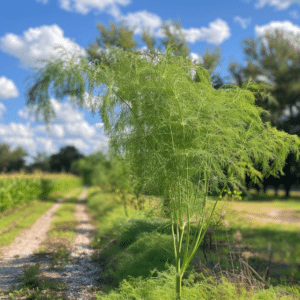Fennel is a versatile and nutritious herb that can be grown in your own garden. Whether you are a seasoned gardener or a beginner, this comprehensive guide will provide you with all the information you need to successfully cultivate fennel plants. From understanding the history and nutritional benefits of fennel to preparing the soil, planting, caring, and harvesting, we will cover every step of the process. So let’s dive in and learn how to grow fennel like a pro!
Understanding Fennel: An Overview

Before delving into the intricacies of growing fennel, it’s important to understand the basics of this incredible herb. Fennel has a long history of cultivation, dating back thousands of years. It was used in ancient civilizations for medicinal, culinary, and even mystical purposes. Today, fennel is known for its aromatic flavor and various health benefits.
When we explore the history of fennel cultivation, we discover its fascinating journey through time. Throughout history, fennel has been cultivated in many regions around the world. The ancient Egyptians, for instance, used it in religious ceremonies and believed it had magical properties. They revered fennel for its ability to ward off evil spirits and bring good luck. Fennel was considered a sacred herb and was often placed in tombs to accompany the deceased on their journey to the afterlife.
As civilization progressed, fennel found its way to Europe through the Romans. The Romans recognized the culinary potential of fennel and incorporated it into their cuisine. They used it as a flavoring agent in various dishes, from soups to sauces. Fennel became a staple herb in Roman cooking, adding a unique and refreshing taste to their meals.
In modern times, fennel has become a popular ingredient in many cuisines, particularly in Mediterranean and Indian dishes. Its distinct flavor adds depth and complexity to a wide range of recipes. Whether it’s a fragrant curry or a refreshing salad, fennel brings a delightful twist to the table.
The Nutritional Benefits of Fennel
Fennel is not only a flavorful herb but also a nutritional powerhouse. It is a great source of vitamins A and C, as well as fiber and potassium. These essential nutrients play a crucial role in maintaining overall health and well-being.
One of the standout features of fennel is its high fiber content. Fiber is essential for a healthy digestive system, promoting regular bowel movements and preventing constipation. Additionally, fennel’s fiber content can help regulate blood sugar levels and lower cholesterol, reducing the risk of heart disease.
Furthermore, fennel contains antioxidants that help protect against chronic diseases. These antioxidants, such as flavonoids and phenolic compounds, have been shown to have anti-inflammatory and anticancer properties. Incorporating fennel into your diet can help reduce inflammation in the body and support a healthy immune system.
Another noteworthy benefit of fennel is its potential to aid in weight management. With its low calorie and high fiber content, fennel can help you feel full and satisfied, reducing the urge to overeat. It can be a valuable addition to a balanced diet for those looking to maintain a healthy weight.
In conclusion, fennel is not just an ordinary herb. Its rich history, diverse culinary uses, and impressive nutritional profile make it a standout ingredient. Whether you’re a fan of its distinct flavor or seeking to reap its health benefits, fennel is a versatile herb that deserves a place in your kitchen and your wellness routine.
Preparing the Soil for Fennel Plantation
Before you can start planting fennel, it’s crucial to prepare the soil properly. Fennel thrives in well-draining soil that is rich in organic matter. Here are a few essential steps to get your soil ready for fennel cultivation.
Firstly, it’s important to understand the ideal soil conditions for fennel. Fennel prefers soil with a pH level between 5.5 and 7.5. This slightly acidic to neutral pH range provides the optimal environment for fennel growth. Additionally, fennel grows best in loamy or sandy soil that is not too heavy. These soil types allow for good drainage, preventing waterlogging which can be detrimental to fennel plants.
Now that you know the ideal soil conditions, let’s dive into enhancing soil fertility for fennel growth. One effective way to improve soil fertility is by adding organic matter such as compost or well-rotted manure to the soil. Organic matter is rich in nutrients that are essential for plant growth, providing a natural source of nourishment for your fennel plants. When incorporating organic matter into the soil, it’s recommended to do so a few weeks before planting fennel. This allows the organic matter to decompose and enrich the soil, ensuring that the nutrients are readily available for the fennel plants.
When preparing the soil, it’s also crucial to remove any weeds or grass that may compete with the fennel plants for nutrients and space. Clearing the area of unwanted vegetation will give your fennel plants a better chance to thrive.
Another important aspect of soil preparation is loosening the soil. This can be done by tilling or digging the soil to break up any compacted areas. Loosening the soil helps improve aeration and allows the fennel roots to penetrate the soil more easily, promoting healthy growth.
Furthermore, it’s beneficial to perform a soil test before planting fennel. A soil test will provide valuable information about the nutrient levels and pH of your soil. Based on the test results, you can make any necessary adjustments to ensure that the soil is in optimal condition for fennel cultivation.
Lastly, it’s important to note that fennel is a sun-loving plant. When choosing the location for your fennel plantation, select an area that receives full sun for at least six to eight hours a day. Adequate sunlight is crucial for the growth and development of fennel plants.
Planting Fennel: Step-by-Step Guide

Now that you have prepared your soil, it’s time to plant fennel. Here is a step-by-step guide to help you successfully establish your fennel garden.
When to Plant Fennel
Fennel can be planted outdoors in early spring once the soil has warmed up or in late summer for a fall harvest. It thrives in cooler temperatures and can tolerate light frosts. Consider the climate in your region when determining the best time to plant fennel.
How to Plant Fennel Seeds
Start by sowing fennel seeds directly into the prepared soil. Plant the seeds about ½ inch deep and 12 to 18 inches apart, leaving enough space for the plants to grow. Water gently to keep the soil moist but not soaked. Within a couple of weeks, you should see sprouts emerging from the soil.
Caring for Your Fennel Plants
Once your fennel plants have sprouted, proper care is essential for their development. From watering and feeding to pest control, here’s what you need to know.
Watering and Feeding Fennel Plants
Keep the soil evenly moist throughout the growing season, especially during dry periods. Be careful not to overwater, as fennel prefers slightly drier conditions. Mulching around the plants can help retain moisture and suppress weeds. Additionally, fennel benefits from regular feeding with a balanced organic fertilizer to promote healthy growth.
Dealing with Pests and Diseases
Fennel plants are relatively resistant to pests and diseases. However, they can occasionally be affected by aphids, slugs, or fungal infections. Inspect your plants regularly and take appropriate measures if you notice any signs of damage. In some cases, removing affected parts or using organic pest control methods will suffice.
Harvesting and Storing Fennel

After months of caring for your fennel plants, it’s time to reap the rewards. Here’s what you need to know about harvesting and storing fennel.
When and How to Harvest Fennel
Harvest fennel bulbs when they reach a desirable size, typically around 3 to 4 inches in diameter. To harvest, cut the bulbs at the base of the plant using a sharp knife. Additionally, you can harvest fennel fronds (the feathery leaves) for culinary uses throughout the growing season.
Best Practices for Storing Fennel
To store fennel bulbs, remove the fronds and store them separately in the refrigerator. The bulbs can be stored in a plastic bag or container in the refrigerator for up to a week. For longer-term storage, you can blanch and freeze fennel bulbs.
By following this comprehensive guide, you will be well-equipped to successfully grow fennel in your garden. From understanding the history and nutritional benefits of fennel to preparing the soil, planting, caring, and harvesting, each step plays a vital role in the cultivation process. So roll up your sleeves, get your hands dirty, and enjoy the process of growing your own delicious and nutritious fennel!